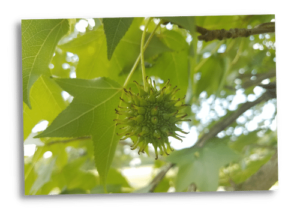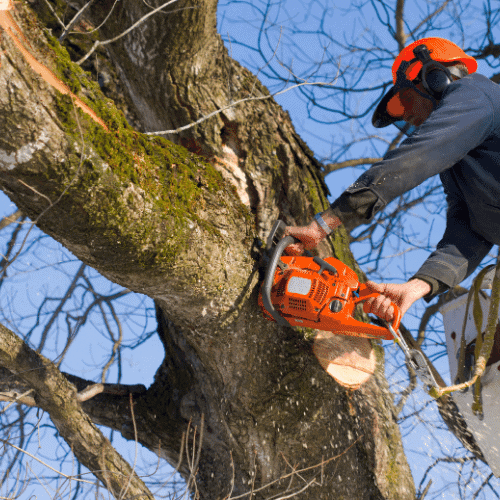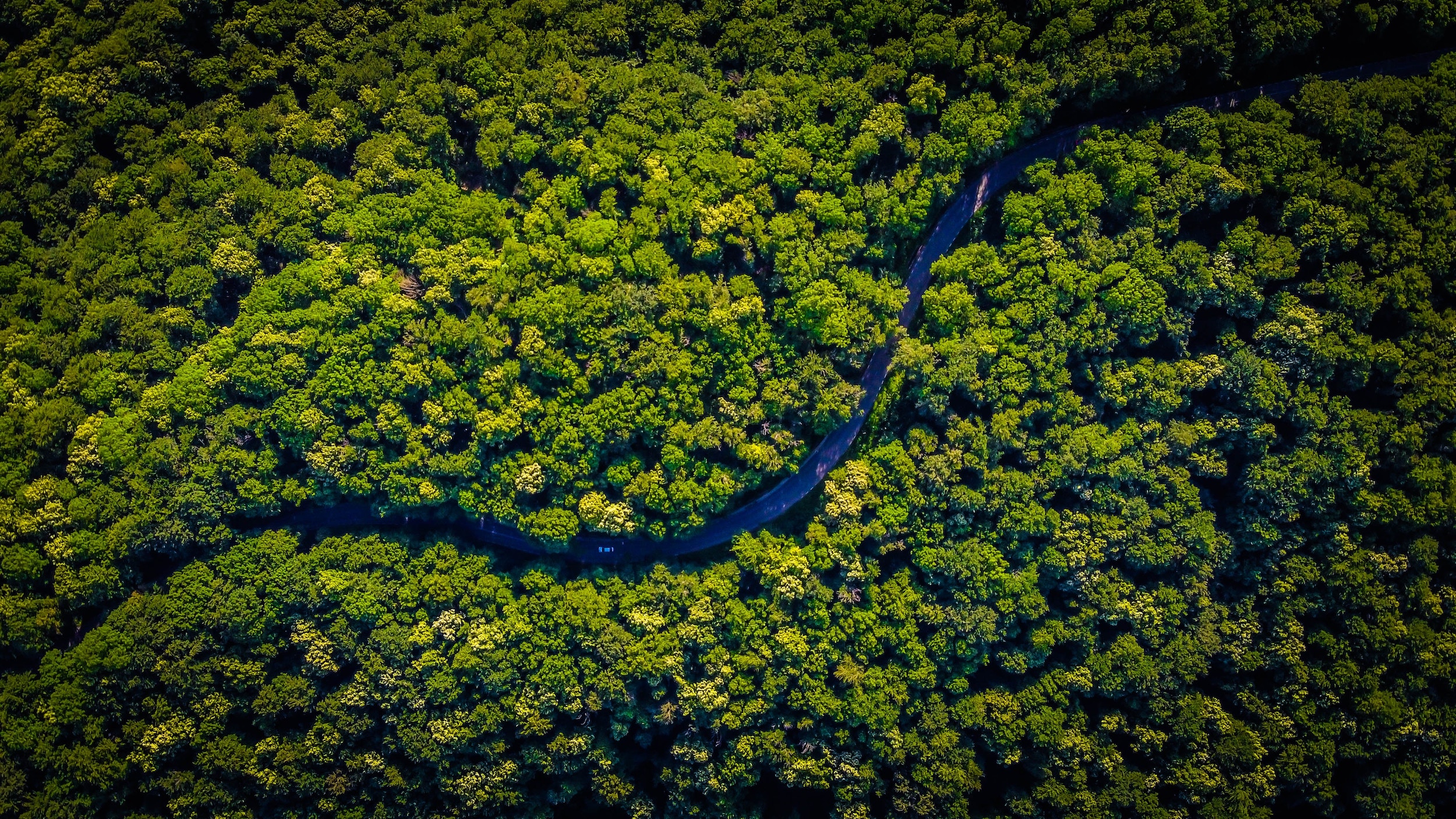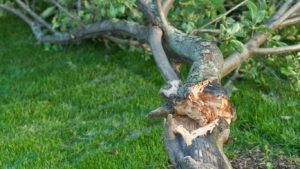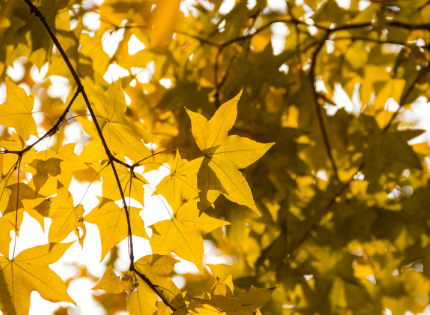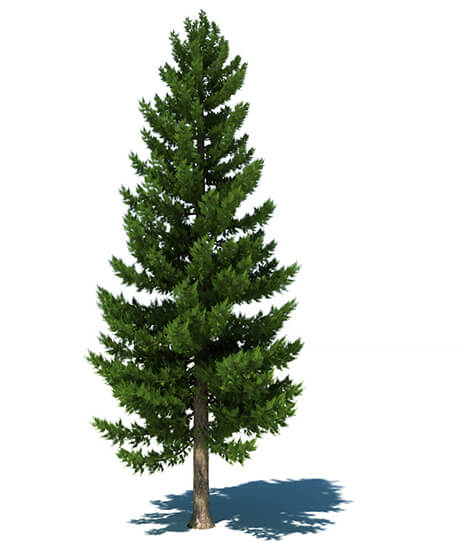Contents (Click To Jump)
- 1 Things to Consider Before Planting a Tree
- 2 Type of Tree
- 3 Pre-Planting Area
- 4 Location of the Tree
- 5 Local guidelines
- 6 Sun exposure
- 7 Think long-term
- 8 Proximity to structures and pavement
- 9 Avoid sewer lines and power lines
- 10 Property lines
- 11 Other trees
- 12 Best Time of Year to Plant
- 13 How to Plant a Tree
- 14 Bare Root
- 15 Containerized
- 16 Burlapped
- 17 Tips for Planting Trees
- 18 Planting Mature Trees
- 19 How Much Does it Cost to Plant a Mature Tree?
Things to Consider Before Planting a Tree
Type of Tree
It is very important to choose a tree type that does well in your climate, soil, and sun exposure conditions.
The best way to do this is to choose a tree that is recommended for your hardiness zone. Hardiness zones are areas of the United States and Canada that are divided up based on climate. To find out your hardiness zone, here is a quick reference chart:
- 40°F through 30°F
- 30°F through 20°F
- 20°F through 10°F
- 10°F through 0°F
- 0°F through -10°F
- -10°F through -20°F
- -20°F through -30°F
- -30°F through -40°F
Pre-Planting Area

You may want to consider first planting the new tree in a well-protected area with rich soil such as a fenced in garden. Then transport the tree a year or two later to your desired long-term spot.
Location of the Tree
If you are ready to commit to a final spot now, here are some things to consider when determining a location:

Local guidelines
Your local governing bodies may have restrictions when it comes to tree planting. Be sure to check with them before planting your tree.

Sun exposure
You will want your tree to be exposed to the level of sun that best suits it. For example, if your tree requires full sun, then make sure you choose a very sunny spot for it. If it performs best in partial sun, you should map out a spot that gets some shade throughout the day.

Think long-term
Depending on the tree type that you choose, this tree could grow to be very large. It may look nice somewhere now, but will it still look nice in a couple of decades when it is huge? Will it cause an issue or obstruct something you don’t want obstructed? Plan ahead before determining the plot for the tree so you don’t have to call in a tree removal company later.

Proximity to structures and pavement
As trees grow, their roots can start to break apart patios, driveways, and sidewalks. They can also start growing into structures causing even more problems. Make sure to plant your tree at least five feet from pavement and 25 feet from structures.

Avoid sewer lines and power lines
Think about the long-term growth of your tree and if it is endangering any sewer lines or power lines. These are issues you definitely want to avoid. If you are planting near power lines, be sure to choose a tree that matures to a very small size.

Property lines
Try not to conflict with plantings on your neighbor’s property or plant anywhere that could hurt the value of their home. As a good rule, plant at least two feet from property lines.

Other trees
You will need to consider a tree’s size at maturity before planting near another tree. You do not want trees to be too close and competing for space, as that may end in death for both trees.
Best Time of Year to Plant
The best time to plant or transplant a tree is when it is dormant. There are two common times for this:
In the fall, after deciduous trees have lost their leaves
In the spring before leaves grow
How to Plant a Tree

Most new trees come in three different forms: bare root, containerized, or with a root ball covered in burlap. Below is a step-by-step guide for planting each kind of tree.
Bare Root
 UntangleCarefully remove the tree from its packaging and untangle the roots.
UntangleCarefully remove the tree from its packaging and untangle the roots. Soak the rootsFill a large bucket with water and place the tree inside of it so that all of the roots are under water. Soak for three to six hours.
Soak the rootsFill a large bucket with water and place the tree inside of it so that all of the roots are under water. Soak for three to six hours. Dig a holeMake sure the hole is two to three times as wide as the tree roots and deep enough to fit all of the tree roots.
Dig a holeMake sure the hole is two to three times as wide as the tree roots and deep enough to fit all of the tree roots. Prepare the surrounding soilRemove any weeds or grass within a few feet of the tree. They will only take resources that your tree needs to survive during this fragile time. Turn the soil in that area as well in order to encourage oxygen and water flow through the soil.
Prepare the surrounding soilRemove any weeds or grass within a few feet of the tree. They will only take resources that your tree needs to survive during this fragile time. Turn the soil in that area as well in order to encourage oxygen and water flow through the soil. Place the tree in the holePut the tree inside of your freshly dug hole and position it where you would like it.
Place the tree in the holePut the tree inside of your freshly dug hole and position it where you would like it. Fill in the holeSlowly add soil back into the hole around the roots. Do not pack the soil too tightly. Loose soil is better so that there is no obstruction blocking the roots from getting the resources they need to thrive and grow.
Fill in the holeSlowly add soil back into the hole around the roots. Do not pack the soil too tightly. Loose soil is better so that there is no obstruction blocking the roots from getting the resources they need to thrive and grow. Add a stakeNewer trees need a stake to help them settle in and grow in the right direction. Drive a stake in right next to the tree and attach it to the trunk. Make sure it is loosely attached as it is a gentle guide for the tree rather than attaching it tightly. You do not want it to hinder its growth.
Add a stakeNewer trees need a stake to help them settle in and grow in the right direction. Drive a stake in right next to the tree and attach it to the trunk. Make sure it is loosely attached as it is a gentle guide for the tree rather than attaching it tightly. You do not want it to hinder its growth. WaterWater the newly planted tree generously. New trees need plenty of water in their earliest months and throughout their first year.
WaterWater the newly planted tree generously. New trees need plenty of water in their earliest months and throughout their first year. MulchAdding mulch around the base of the tree and over its roots will help protect it from extreme temperatures and weed growth. The mulch layer you add should be about two inches deep and spread about three feet in diameter.
MulchAdding mulch around the base of the tree and over its roots will help protect it from extreme temperatures and weed growth. The mulch layer you add should be about two inches deep and spread about three feet in diameter.
Containerized

Dig
Your hole for the tree should be three to four times as wide as the container. Make sure the hole is deep enough so that the tree collar will sit just above ground level.

Remove the container
To remove the tree from the container without damaging the roots, carefully tilt the tree slightly upside down and tap the outside of the container. This should loosen its hold a bit. Then slowly remove the tree from the container.

Make sure roots are not rootbound
Sometimes when plants have been left in a container long enough and are unable to grow into new space, their growth slows and their roots become rootbound. If the bottom of the root ball looks like the roots are circling back into the root ball, then take a cutting tool and cut an “X” at the bottom of the root ball as well as four vertical lines down the sides of the root ball.
Insert the tree
It is time to place the tree into the hole that you dug. Put the tree in the desired position before securing it with soil.
Fill with soil
Put the soil back into the hole surrounding the tree to secure it in place. If the top of the root ball is lower than ground level, then shift the tree over and compact some soil under where you would like it to go to raise the tree up. The root collar should be above ground level.
Stake it
Position a stake next to the tree so that it is parallel to it and sticks into the root ball. Loosely attach the stake to the tree.
Remove any tape or tags from the tree
These could hinder the tree’s growth and additionally, they are not pleasing to the eye.
Water the tree
Give the tree a good watering. It will need a lot of water during this period of establishment over the first year.
Add mulch
Put a two inch layer of mulch that is three feet in diameter around the base of the tree to protect it.
Burlapped
 Hole digging timeGrab a shovel and dig a hole that is twice as wide as the root ball. The depth of the hole should also fit the entire root ball so the root collar sits slightly above the surrounding ground.
Hole digging timeGrab a shovel and dig a hole that is twice as wide as the root ball. The depth of the hole should also fit the entire root ball so the root collar sits slightly above the surrounding ground. Till the surrounding groundTill about two feet worth of ground surrounding the root ball.
Till the surrounding groundTill about two feet worth of ground surrounding the root ball. Holding the tree from the root ball, carefully set it into the holePreserving the root ball is very important when planting a tree. The last thing you want is for the root ball to detach from the tree trunk.
Holding the tree from the root ball, carefully set it into the holePreserving the root ball is very important when planting a tree. The last thing you want is for the root ball to detach from the tree trunk. Cut off the burlap and tiesStarting from the bottom and going up, cut a vertical line up the side of the burlap and peel it away. If the burlap is untreated burlap, then it is fine to leave some behind underneath the tree. However, if it is treated then you should remove it.
Cut off the burlap and tiesStarting from the bottom and going up, cut a vertical line up the side of the burlap and peel it away. If the burlap is untreated burlap, then it is fine to leave some behind underneath the tree. However, if it is treated then you should remove it. Fill ‘er upPut the original soil back into the hole, filling it in around the tree.
Fill ‘er upPut the original soil back into the hole, filling it in around the tree. Add waterGive your tree a healthy helping of water. Make sure to water the tree regularly during this vulnerable time. It will need all the help it can get.
Add waterGive your tree a healthy helping of water. Make sure to water the tree regularly during this vulnerable time. It will need all the help it can get. It’s mulchin’ timeMulch protects trees from extreme weather conditions and hinders weeds from popping up and trying to compete with them for resources. Add a layer of mulch that is about two inches deep and three feet in diameter.
It’s mulchin’ timeMulch protects trees from extreme weather conditions and hinders weeds from popping up and trying to compete with them for resources. Add a layer of mulch that is about two inches deep and three feet in diameter.
Tips for Planting Trees
 Water a Whole LotNewly planted trees need lots of water during their first year after planting. You want the soil to be moist, but never soggy. Overwatering is just as dangerous as underwatering.
Water a Whole LotNewly planted trees need lots of water during their first year after planting. You want the soil to be moist, but never soggy. Overwatering is just as dangerous as underwatering. Don’t Use Fertilizer on New TreesFertilizer is only detrimental to the tree if added in its first year. Its nutrients need to be minimal as it establishes its root system. After one year, then fertilizer is more appropriate for the tree.
Don’t Use Fertilizer on New TreesFertilizer is only detrimental to the tree if added in its first year. Its nutrients need to be minimal as it establishes its root system. After one year, then fertilizer is more appropriate for the tree. Add a Protective BarrierSince brand new trees are very fragile, consider putting a temporary fence around the base of your tree to protect it from nearby wildlife.
Add a Protective BarrierSince brand new trees are very fragile, consider putting a temporary fence around the base of your tree to protect it from nearby wildlife.
Planting Mature Trees
If you are not interested in waiting around for a young tree to mature and fill a space the way you want it to, then you may want to consider planting mature trees. This will allow you to achieve your desired look for the landscape much faster, but it will cost more. It is a process that will require a team of professionals and some heavy equipment.
Here is generally what takes place in the mature tree planting process:

The tree planting team comes in to assess the area and map out how their equipment can safely operate around your property and any possible obstructions.

A machine will dig a large whole in your yard where the tree will go.

A truck will bring in the tree from the nursery where this tree has been growing. It will have a significant root plug attached.

The truck will then lower the tree and root plug into position in the hole.

The team of tree professionals will fill in the remaining space with soil and add any ropes or stakes that may be needed, add a layer of mulch, and water the tree.

Listen carefully to the care tips that the tree professionals give you, so that you can do your part to help this tree transplant succeed.
How Much Does it Cost to Plant a Mature Tree?
The cost of planting a tree depends on a variety of factors including tree size, tree type, difficulty of the planting job, and local labor costs.
With so many different factors, the range in pricing is significant. Buying a tree can cost anywhere between $75 and $2,000, so tree type and size can have a huge impact on your final price. Add that to transport and labor costs for the job and the average cost of planting a mature tree can range between $600 and $12,000.

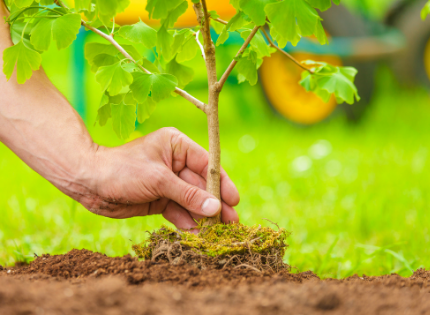
 UntangleCarefully remove the tree from its packaging and untangle the roots.
UntangleCarefully remove the tree from its packaging and untangle the roots. Soak the rootsFill a large bucket with water and place the tree inside of it so that all of the roots are under water. Soak for three to six hours.
Soak the rootsFill a large bucket with water and place the tree inside of it so that all of the roots are under water. Soak for three to six hours. Dig a holeMake sure the hole is two to three times as wide as the tree roots and deep enough to fit all of the tree roots.
Dig a holeMake sure the hole is two to three times as wide as the tree roots and deep enough to fit all of the tree roots. Prepare the surrounding soilRemove any weeds or grass within a few feet of the tree. They will only take resources that your tree needs to survive during this fragile time. Turn the soil in that area as well in order to encourage oxygen and water flow through the soil.
Prepare the surrounding soilRemove any weeds or grass within a few feet of the tree. They will only take resources that your tree needs to survive during this fragile time. Turn the soil in that area as well in order to encourage oxygen and water flow through the soil. Place the tree in the holePut the tree inside of your freshly dug hole and position it where you would like it.
Place the tree in the holePut the tree inside of your freshly dug hole and position it where you would like it. Fill in the holeSlowly add soil back into the hole around the roots. Do not pack the soil too tightly. Loose soil is better so that there is no obstruction blocking the roots from getting the resources they need to thrive and grow.
Fill in the holeSlowly add soil back into the hole around the roots. Do not pack the soil too tightly. Loose soil is better so that there is no obstruction blocking the roots from getting the resources they need to thrive and grow. Add a stakeNewer trees need a stake to help them settle in and grow in the right direction. Drive a stake in right next to the tree and attach it to the trunk. Make sure it is loosely attached as it is a gentle guide for the tree rather than attaching it tightly. You do not want it to hinder its growth.
Add a stakeNewer trees need a stake to help them settle in and grow in the right direction. Drive a stake in right next to the tree and attach it to the trunk. Make sure it is loosely attached as it is a gentle guide for the tree rather than attaching it tightly. You do not want it to hinder its growth. WaterWater the newly planted tree generously. New trees need plenty of water in their earliest months and throughout their first year.
WaterWater the newly planted tree generously. New trees need plenty of water in their earliest months and throughout their first year. MulchAdding mulch around the base of the tree and over its roots will help protect it from extreme temperatures and weed growth. The mulch layer you add should be about two inches deep and spread about three feet in diameter.
MulchAdding mulch around the base of the tree and over its roots will help protect it from extreme temperatures and weed growth. The mulch layer you add should be about two inches deep and spread about three feet in diameter. Hole digging timeGrab a shovel and dig a hole that is twice as wide as the root ball. The depth of the hole should also fit the entire root ball so the root collar sits slightly above the surrounding ground.
Hole digging timeGrab a shovel and dig a hole that is twice as wide as the root ball. The depth of the hole should also fit the entire root ball so the root collar sits slightly above the surrounding ground. Till the surrounding groundTill about two feet worth of ground surrounding the root ball.
Till the surrounding groundTill about two feet worth of ground surrounding the root ball. Holding the tree from the root ball, carefully set it into the holePreserving the root ball is very important when planting a tree. The last thing you want is for the root ball to detach from the tree trunk.
Holding the tree from the root ball, carefully set it into the holePreserving the root ball is very important when planting a tree. The last thing you want is for the root ball to detach from the tree trunk. Cut off the burlap and tiesStarting from the bottom and going up, cut a vertical line up the side of the burlap and peel it away. If the burlap is untreated burlap, then it is fine to leave some behind underneath the tree. However, if it is treated then you should remove it.
Cut off the burlap and tiesStarting from the bottom and going up, cut a vertical line up the side of the burlap and peel it away. If the burlap is untreated burlap, then it is fine to leave some behind underneath the tree. However, if it is treated then you should remove it. Fill ‘er upPut the original soil back into the hole, filling it in around the tree.
Fill ‘er upPut the original soil back into the hole, filling it in around the tree. Add waterGive your tree a healthy helping of water. Make sure to water the tree regularly during this vulnerable time. It will need all the help it can get.
Add waterGive your tree a healthy helping of water. Make sure to water the tree regularly during this vulnerable time. It will need all the help it can get. It’s mulchin’ timeMulch protects trees from extreme weather conditions and hinders weeds from popping up and trying to compete with them for resources. Add a layer of mulch that is about two inches deep and three feet in diameter.
It’s mulchin’ timeMulch protects trees from extreme weather conditions and hinders weeds from popping up and trying to compete with them for resources. Add a layer of mulch that is about two inches deep and three feet in diameter. Water a Whole LotNewly planted trees need lots of water during their first year after planting. You want the soil to be moist, but never soggy. Overwatering is just as dangerous as underwatering.
Water a Whole LotNewly planted trees need lots of water during their first year after planting. You want the soil to be moist, but never soggy. Overwatering is just as dangerous as underwatering. Don’t Use Fertilizer on New TreesFertilizer is only detrimental to the tree if added in its first year. Its nutrients need to be minimal as it establishes its root system. After one year, then fertilizer is more appropriate for the tree.
Don’t Use Fertilizer on New TreesFertilizer is only detrimental to the tree if added in its first year. Its nutrients need to be minimal as it establishes its root system. After one year, then fertilizer is more appropriate for the tree. Add a Protective BarrierSince brand new trees are very fragile, consider putting a temporary fence around the base of your tree to protect it from nearby wildlife.
Add a Protective BarrierSince brand new trees are very fragile, consider putting a temporary fence around the base of your tree to protect it from nearby wildlife.